The Economics and Statistics Division maintains archives of previous publications for accountability purposes, but makes no updates to keep these documents current with the latest data revisions from Statistics Canada. As a result, information in older documents may not be accurate. Please exercise caution when referring to older documents. For the latest information and historical data, please contact the individual listed to the right.
<--- Return to Archive
For additional information relating to this article, please contact:
August 02, 2022POLICE REPORTED CRIME STATISTICS, 2021 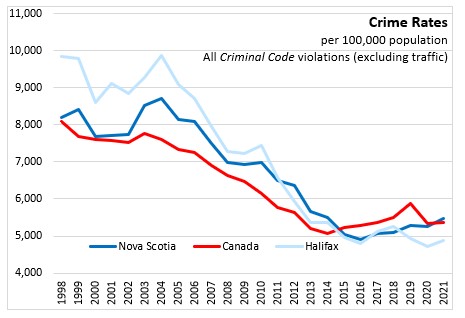
Statistics Canada has released the 2021 results for police-reported crime statistics collected under the Uniform Crime Reporting (UCR) Survey. This annual publication measures the volume of crime, crime rates (per 100,000 population), and crime severity (based on sentencing data) by types of crime.
In 2021, Canada's crime rate (Criminal Code violations excluding traffic) was 5,375 incidents per 100,000 population. In comparison, Nova Scotia's crime rate for 2021 was 5,482 per 100,000 population. This was the first time since 2014 that Nova Scotia's crime rate was higher than the national average. The lowest crime rates among provinces were in Quebec and Ontario.
Halifax's crime rate increased to 4,884 incidents per 100,000 population.
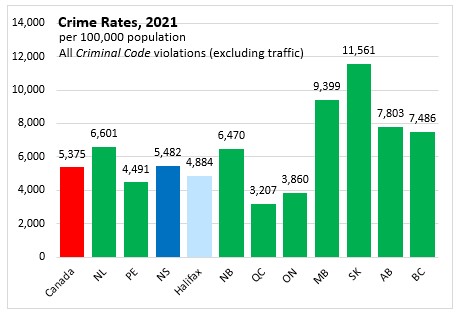
Nova Scotia's crime rate (Criminal Code, excluding traffic) increased 4.0% in 2021, while there was a 3.8% increase in Halifax.
Canada's crime rate increased by 0.7% in 2021. Across Canada, crime rates increased in six provinces led by Newfoundland and Labrador (+9.5%). Crime rates declined year-over-year in four provinces with Alberta (-4.6%) reporting the largest decline.

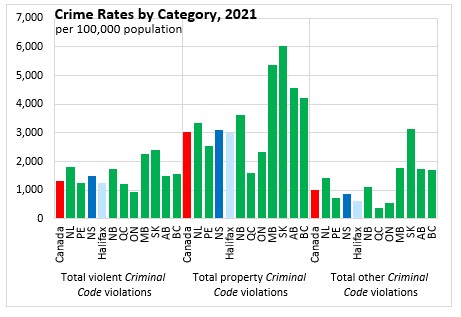
In 2021, there were 23 homicides in Nova Scotia, 14 less than in 2020 when a mass shooting happened in the province.
In Nova Scotia there were 1,498 violent police-reported incidents per 100,000 residents in 2021. The national violent crime rate was 1,323 violations per 100,000 residents.
There were 3,098 property violations per 100,000 residents in Nova Scotia and 886 other Criminal Code violations. Nationally, there were 3,044 property violations and 1,008 other Criminal Code violations per 100,000 residents.
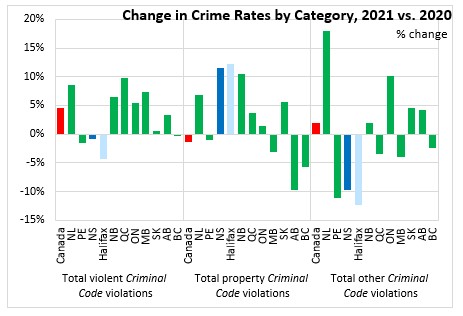
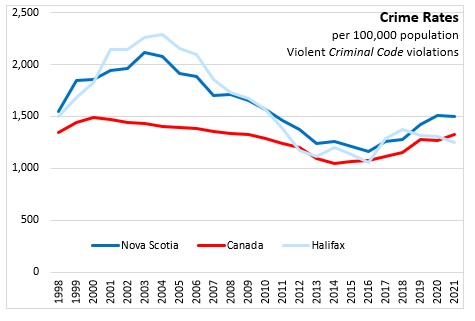

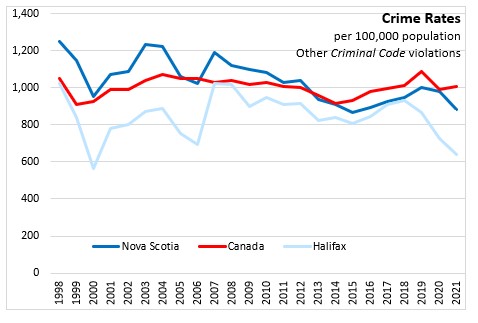
In the last year, the violent crime rate was down 0.9% in Nova Scotia, including the mass shooting in 2020 The rate of violent crime decreased by 4.4% in Halifax and increased by 4.6% nationally.
Property crime rates were up 11.6% in Nova Scotia and 12.2% in Halifax while the national property crime rate decreased by 1.3%. Other Criminal Code violations were down 9.7% in Nova Scotia, down 12.4% in Halifax and up 1.9% nationally.

Nova Scotia reported 394 Criminal Code traffic violations per 100,000 residents in 2021, which was above the national average of 311. There were 206 Criminal Code traffic violations per 100,000 residents in Halifax.
Nova Scotia's drug violation rate was 96 per 100,000 residents while Halifax's was 60. The national drug violation rate was 162 per 100,000 residents.
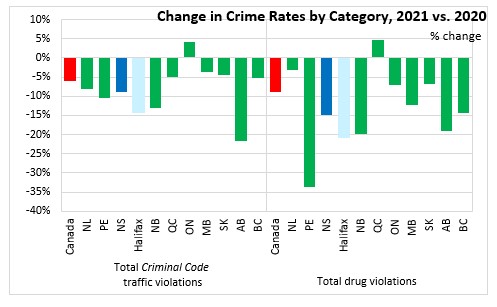

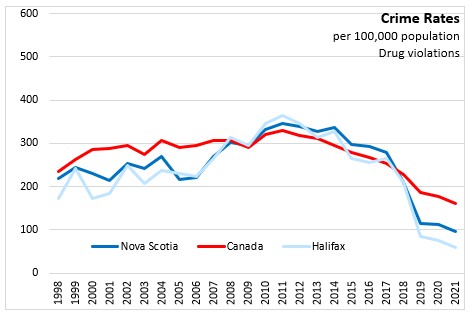
The rate of Criminal Code traffic violations decreased by 8.9% in Nova Scotia in 2021 (-14.1% in Halifax), which was higher than the national decline of 5.9%. The rate of drug violations was down 14.9% (-20.7% in Halifax) in 2021. The rate of drug violations was down 8.9% nationally.
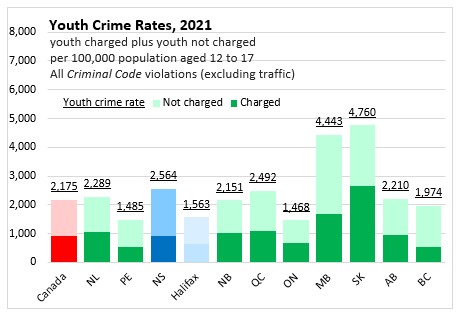
Nova Scotia's youth crime rate in 2021 was 2,564 violations per 100,000 residents aged 12-17, which was higher than the national youth crime rate (2,175). The youth crime rate was lower in Halifax (1,563). Youth crime rates were higher in Manitoba and Saskatchewan. Note the youth crime rates are divided into youth who are charged for a reported crime and youth who are not charged for a reported crime.
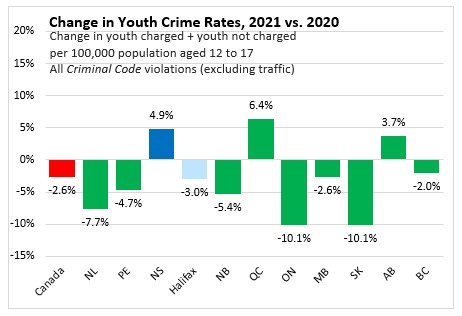
The youth crime rate increased 4.9% in Nova Scotia (-3.0% in Halifax) while the national youth crime rate declined 2.6%. Youth crime rates were down substantially in all provinces with the exception of Nova Scotia, Quebec and Alberta from 2020 to 2021.
The overall severity of crime, as measured by the Total Crime Severity Index (CSI), declined 0.8% in Nova Scotia but increased 6.0% for Halifax in 2020.
Nationally, the total CSI decreased 0.3% in 2021, the second consecutive year-over-year decline. Statistics Canada noted that the year-over-year changes in the Violent and Non-Violent CSIs moved in opposite directions for the first time since 2006.
The severity of violent crime declined 5.5% in Nova Scotia but increased by 8.3% in Halifax. National violent crime severity in increased 5.1% in 2021. The increase in violent crime compared with 2020 was attributable in part to higher rates of level 1 sexual assault, harassing and threatening behaviours, and homicide, among others. Police-reported sexual assaults increased 18.4% year-over-year in Canada, and 6.8% in Nova Scotia in 2021.
Non-violent crime severity was up 2.0% in Nova Scotia, 4.6% in Halifax. Nationally, non-violent crime severity declined 2.8%, posting the second consecutive decline following five years of increases.
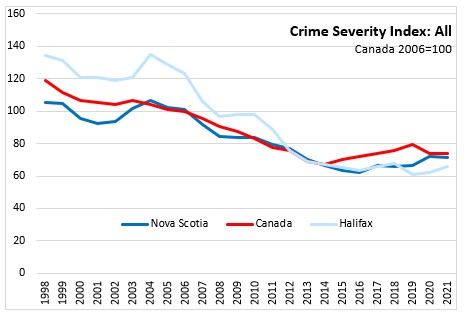
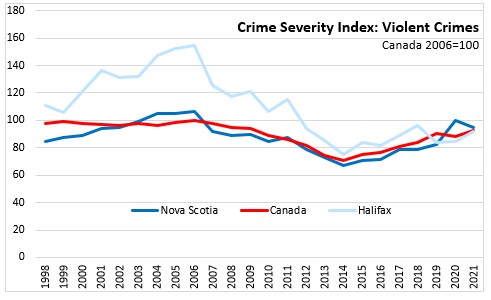
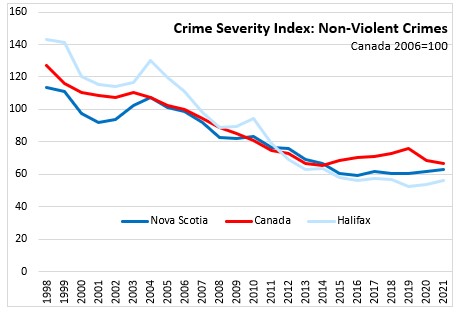
NOTE: on January 1, 2018, Statistics Canada, in collaboration with police, changed the definition of “founded” criminal incidents. With the new definition, there is the potential that police will classify more incidents as founded.
Definitions:
Incident (or Offence): A criminal incident involves one or more related offences that are committed during a single criminal event and have been reported to police.
Violent offences: Involve the use or threat of violence against a person, including homicide, attempted murder, assault, sexual assault and robbery.
Non-violent offences: Include property offences and other Criminal Code offences, as well as Criminal Code traffic offences, drug-related offences and violations of other federal statutes.
Sexual assault: Is classified by level in the Criminal Code into three separate categories—depending on the nature and severity of the incident—including level 1, assault of a sexual nature that violates the sexual integrity of the victim; level 2, sexual assault with a weapon or causing bodily harm involves sexual assault with a weapon, threats to use a weapon or causing bodily harm; and level 3, aggravated sexual assault involves sexual assault that wounds, maims, disfigures or endangers the life of the victim.
“Other” Criminal Code offences: Include crimes such as disturbing the peace and offences against the administration of justice (e.g., failure to comply with an order, failure to appear and breach of probation).
Source: Statistics Canada. Table 35-10-0026-01 Crime severity index and weighted clearance rates, Canada, provinces, territories and Census Metropolitan Areas, Table 35-10-0177-01 Incident-based crime statistics, by detailed violations, Canada, provinces, territories and Census Metropolitan Areas
<--- Return to Archive